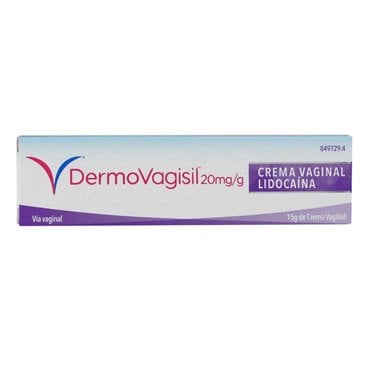Dermovagisil 20 Mg/G Vaginal Cream 20 G
It is a cream for use in the vaginal area, which contains an active principle with local anesthetic action. Dermovagisil vaginal cream is indicated for the temporary and local symptomatic relief of mild itching of the external vaginal area, such as that due to underwear, soaps or deodorants. Dermovagisil vaginal cream is indicated for adults and girls over 12 years of age.
It is a cream for use in the vaginal area, which contains an active principle with local anesthetic action. Dermovagisil vaginal cream is indicated for the temporary and local symptomatic relief of mild itching of the external vaginal area, such as that due to underwear, soaps or deodorants. Dermovagisil vaginal cream is indicated for adults and girls over 12 years of age.
Dermovagisil (20 Mg/G Vaginal Cream 1 Tube 20 G)
lidocaine
COMPOSITION
Each g contains 20 mg of lidocaine (2%).
ACTION AND MECHANISM
- Local anesthetic of the amide type. Lidocaine blocks Na+-voltage-gated channels, decreasing neuronal depolarization velocity and nerve stimulus conduction velocity. The block is reversible, and once the concentration falls below a minimum threshold, the nerve fully recovers its nerve function.
The blocking effect is not accompanied by changes in resting potential or repolarization.
The anesthetic effects appear rapidly, in about 3-5 min, and last for about 1.5 h.
PHARMACOKINETICS
- Absorption: systemic bioavailability depends on the amount of lidocaine applied, application time and skin condition. Thus, absorption through intact skin is very low, but it could increase when applied to mucous membranes or damaged skin.
- Distribution: moderate binding to plasma proteins (65%), mainly to alpha-1 acid glycoprotein. The Vd is 1.5 l/kg. Like other local anesthetics, it is capable of crossing the BBB and placenta.
- Metabolism: intense hepatic metabolism (90-95%) through N-dealkylation reactions, giving rise to monoethylglycinexylidide and glycinexilidide. Both hydrolyze to 2,6-xylidine, which is hydroxylated to 4-hydroxy-2,6-xylidine. All metabolites are less active than lidocaine. Metabolism is primarily mediated by CYP1A2, and to a lesser extent CYP3A4.
- Excretion: mainly in urine (90%), with 5-10% unchanged and 80% as 4-hydroxy-2,6-xylidine. The t1/2 after iv administration is 1.5-2 h, while after topical application it can reach 12 h, indicating deposition on the skin and its slow release into the blood. The Clt is 8-10 ml/min/kg.
Pharmacokinetics in special situations:
- Renal failure: t1/2 can increase to 2-3 h, producing accumulation of active metabolites. Lidocaine is removed by hemodialysis.
- Hepatic impairment: accumulation of lidocaine may occur, since metabolism may decrease to 10% of the metabolism observed in patients with normal liver function.
INDICATIONS
- Symptomatic and temporary relief of external [VAGINAL ITCHING], such as that produced by underwear, soap or deodorants.
POSOLOGY
It is recommended to use the minimum dose that allows to eliminate the symptoms to avoid possible systemic effects.
- Adults and adolescents from 12 years: apply a thin layer on the affected area, up to 3-4 times a day.
- Girls under 12 years: safety and efficacy have not been evaluated.
Duration of treatment: do not use for more than 7 days. If after 5 days the symptoms do not improve or even worsen, or if redness, pain or inflammation appears, consult your doctor and/or pharmacist.
Forgotten dose: do not double the next dose.
DOSAGE IN RENAL FAILURE
- Mild to moderate renal insufficiency (CLcr 30-90 ml/min): no dose adjustment is required.
- Severe renal failure (CLcr < 30 ml/min): caution.
DOSAGE IN LIVER FAILURE
- Mild to moderate hepatic impairment (Child-Pugh classes A and B): no dose adjustment required.
- Severe hepatic impairment (Child-Pugh class C): caution.
RULES FOR CORRECT ADMINISTRATION
- Vaginal cream: Apply the vaginal cream on the affected area with a light massage. Wash hands afterwards.
CONTRAINDICATIONS
- Hypersensitivity to lidocaine or [ALLERGY TO AMIDE TYPE LOCAL ANESTHETICS], among which there may be cross hypersensitivity reactions.
PRECAUTIONS
- Severe [KIDNEY FAILURE] (CLcr < 30 ml/min). Safety and efficacy have not been evaluated.
- [LIVER FAILURE]. Risk of accumulation due to its high hepatic metabolism. Caution in patients with severe insufficiency (Child-Pugh class C).
- Cardiotoxicity. Lidocaine has effects on cardiac conductivity and contractility. The efficacy and safety of topical lidocaine in patients with severe cardiovascular diseases such as [HEART FAILURE], [CARDIAC ARRHYTHMIA], [HYPOVOLEMIC SHOCK] or [CARDIOGENIC SHOCK] have not been evaluated. It is recommended to closely monitor these patients, given the risk of worsening, and to monitor cardiac function and ECG. Avoid extensive use.
- Its use on mucous membranes, including the eyes, as well as on irritated, inflamed or wounded skin should be avoided, since it could increase systemic absorption. In case of contact with the eyes, immediately wash them with lukewarm water or saline, and protect them until sensitivity returns, since there is a risk of scratches and corneal irritation.
- [METAHEMOGLOBINEMIA]. Lidocaine could aggravate the symptoms.
ADVICE TO THE PATIENT
- Use the dose that your doctor has recommended.
- Do not apply lidocaine on mucous membranes, including the eyes, or on irritated, inflamed or wounded skin. In case of contact with the eyes, immediately wash them with lukewarm water or saline, and protect them until sensitivity returns.
- Before starting treatment, you should contact your doctor if you have previously suffered or suffer from:
* Serious liver diseases.
* Serious heart disease, including cardiac arrhythmias.
- Tell your doctor if you are being treated with:
* Antiarrhythmic drugs.
* Medicines for myocardial infarction, such as nitroglycerin.
* Nitrofurantoin, an antibiotic for urinary infections.
* Nitroprusside, a medication for high blood pressure.
- Tell your doctor and/or pharmacist if you have any of these symptoms:
* Allergy symptoms, such as skin rashes, hives, a feeling of tightness in the chest, difficulty or noise when breathing or dizziness.
SPECIAL WARNINGS
- The minimum doses that allow to eliminate the symptoms should always be used, to avoid the risk of systemic effects.
- Monitoring:
* Cardiac functionality, including ECG monitoring, in people with severe cardiovascular disease.
INTERACTIONS
No specific interaction studies with topical lidocaine have been performed. It should be noted that in case of significant systemic absorption, the usual interactions with parenterally administered lidocaine could occur.
- Class I and III antiarrhythmics. Risk of potentiation of toxicity.
- Drugs such as nitrates, nitrofurantoin, nitroglycerin, nitroprusside or quinine could increase the risk of methemoglobinemia.
PREGNANCY
Safety in animals : lidocaine did not show teratogenic effects in rats or rabbits. At maternotoxic doses in rabbits, an increase in fetal mortality has been observed. In rats, reduced postnatal survival was reported.
Safety in humans : Lidocaine crosses the placenta. There are no adequate and well-controlled studies in humans. In general, it is recommended that occasional use during pregnancy could be accepted, as long as the lowest possible dose is used and for the shortest possible time.
Effects on fertility : no adverse effects have been reported in male or female rats. No testings in humans have been made.
LACTATION
Safety in animals: no data available.
Safety in humans: the appearance of systemic effects is unlikely since it is administered topically. It passes into breast milk, so a decision must be made whether it is necessary to interrupt breastfeeding or to interrupt/suspend treatment after assessing the benefit/risk ratio in the mother and infant.
CHILDREN
The safety and efficacy in girls under 12 years of age have not been evaluated, so it is recommended to avoid its use.
ADVANCED AGE
No specific problems have been described in the elderly that require a dose readjustment.
EFFECTS ON DRIVING
No special risks on the ability to drive are estimated.
ADVERSE REACTIONS
Adverse reactions are described according to each frequency interval, being considered very common (>10%), common (1-10%), uncommon (0.1-1%), rare (0.01-0.1%). , very rare (<0.01%) or frequency unknown (cannot be estimated from the available data).
- Dermatological: infrequent local adverse reactions, such as redness or paleness, [SKIN IRRITATION], [PRURITUS] or burning sensation. These reactions are usually due to the anesthetic effect on blood vessels, and are usually mild and transient.
- Allergic: rare [CONTACT DERMATITIS]; very rare [HYPERSENSITIVITY REACTIONS], which normally occur with [URTICARIA], [EDEMA], [BRONCHIAL SPASM], and which in severe cases could lead to [ANAPHYLAXIS].
However, in case of significant systemic absorption systemic symptoms may appear (see Lidocaine, N01BB).
ADVERSE REACTIONS RELATING TO EXCIPIENTS
- Because it contains castor oil, it can cause [CUTANEOUS ERUPTIONS] and other skin reactions.
OVERDOSE
Symptoms: due to its route of administration, poisoning is unlikely to occur. However, serious poisoning has been described in young children who received very high topical doses (8.6-17.2 mg/kg).
As with any other local anesthetic, overdose may result in a neurological picture characterized by initial excitement (although this phase may not appear) with nervousness, euphoria, confusion and seizures, followed by depression with drowsiness, loss of consciousness consciousness, respiratory depression, and coma. In addition, symptoms such as nausea, tremors, tinnitus, blurred vision may appear, as well as cardiovascular symptoms such as hypotension, cardiac depression and vascular collapse.
Treatment:
- Antidote: there is no specific antidote.
- General elimination measures: lidocaine is hemodialyzable.
- Monitoring: closely monitor the patient, ensuring their respiratory and cardiovascular function, with ECG and blood pressure monitoring.
- Medication:
* Seizures: IV diazepam (0.1 mg/kg) or succinylcholine (10-50 mg).
* Respiratory depression: oxygen administration.
* Hypotension: vasoconstrictors (preferably with myocardial stimulating activity), administration of parenteral fluids and even blood transfusion.
* Methemoglobinemia: 1% methylene blue, intravenously, at a dose of 1-2 mg/kg over 10 min.



